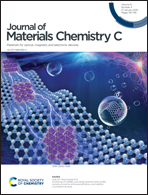Novel triazine derivatives with deep LUMO energy levels as the electron-accepting components of exciplexes†
Abstract
Although a variety of electron-accepting molecules (acceptors) have been reported to develop exciplexes, their LUMO energy levels are still limited from −2.9 to −3.3 eV. This narrow range seriously restricts the development of exciplexes. In this work, three novel triazine-based acceptors, 2,4-diphenyl-6-(3-(phenylsulfonyl)phenyl)-1,3,5-triazine (TRZ-1SO2), 2-phenyl-4,6-bis(3-(phenylsulfonyl)phenyl)-1,3,5-triazine (TRZ-2SO2) and 2,4,6-tris(3-(phenylsulfonyl)phenyl)-1,3,5-triazine (TRZ-3SO2), were developed with deep LUMO energy levels of −3.38, −3.58 and −3.74 eV, respectively. Particularly, TRZ-3SO2 exhibits the deepest LUMO energy level of −3.74 eV among the reported acceptors so far. By combining with an electron-donating molecule, 1,3-bis(9,9-dimethylacridin-10(9H)-yl)benzene (13AB), three exciplexes, 13AB:TRZ-1SO2, 13AB:TRZ-2SO2 and 13AB:TRZ-3SO2, were constructed with the emission from green to orange-red. The OLED using 13AB:TRZ-3SO2 as the emitter exhibits an orange-red emission peaking at 572 nm with a maximum external quantum efficiency of 5.5%. Meanwhile, green and red phosphorescent OLEDs (PhOLEDs) were fabricated using interfacial exciplex hosts by combining these acceptors with 4,4′-bis(carbazole-9-yl)biphenyl (CBP), which successfully exhibits superior performance compared with that of reference devices. These results demonstrate that the three novel acceptors have great potential in the development of exciplexes.



 Please wait while we load your content...
Please wait while we load your content...